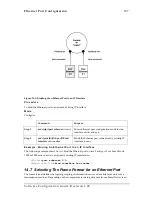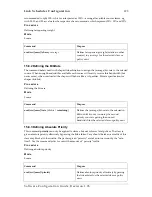
Link Scheduler Configuration
113
Figure 15-1: Service-Policy Profile devoted to an Interface
The link arbiter controls outbound network traffic according to a service-policy profile devoted to a
certain interface, as shown in Figure 15-1. Take into account, that such an interface normally
represents the very bottleneck in the data transmission chain.
In a first step an access control list is used to assign a predefined or user-defined class
to any data
packet and thus classifies every data packet. Please note that predefined classes, e.g. local-voice,
local-default and default, accrue from the SmartNode itself and therefore do not need any packet
classification. Next the link arbiter handles each class corresponding to a user-defined service-policy
profile.
Therefore QoS features in SmartWare are a combination of an access control list, used for packet
classification, and a service-policy profile, used by the link arbiter to define the arbitration mode and
the order in which packets of different classes are served.
The following sections describe methods to assign and share bandwidth on an interface in more
details.
15.2 Quick References
The following sections are useful for administrators familiar with the former SmartWare Release 1.50
or 1.80 QoS configuration if they have to migrate to SmartWare, Release 2.00. Moreover
administrators familiar with Cisco’s IOS QoS features and having to become acquainted with
SmartWare Release 2.00 QoS configuration will find a helpful command cross reference.
Software Configuration Guide, Revision 1.03
















































